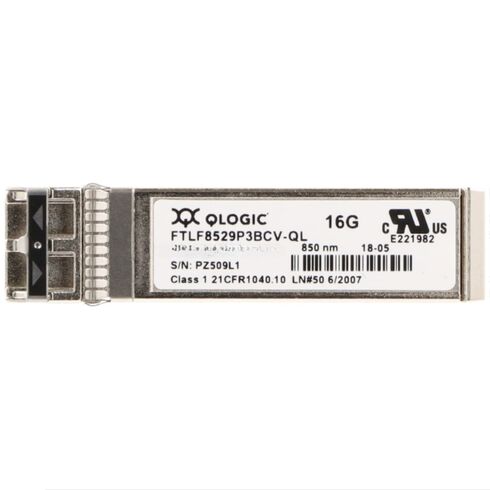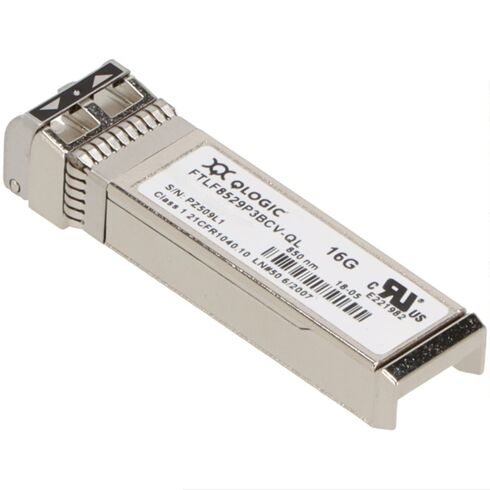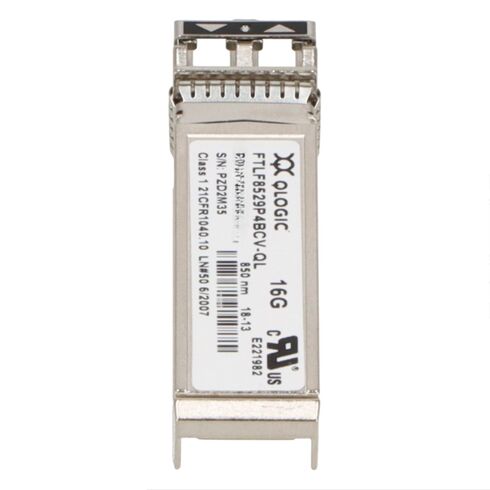FTLF8529P4BCV-QL Qlogic 16GB SFP Transceiver Module 850nm 16GBase-SR Network
- — Free Ground Shipping
- — Min. 6-month Replacement Warranty
- — Genuine/Authentic Products
- — Easy Return and Exchange
- — Different Payment Methods
- — Best Price
- — We Guarantee Price Matching
- — Tax-Exempt Facilities
- — 24/7 Live Chat, Phone Support
- — Visa, MasterCard, Discover, and Amex
- — JCB, Diners Club, UnionPay
- — PayPal, ACH/Bank Transfer (11% Off)
- — Apple Pay, Amazon Pay, Google Pay
- — Buy Now, Pay Later - Affirm, Afterpay
- — GOV/EDU/Institutions PO's Accepted
- — Invoices
- — Deliver Anywhere
- — Express Delivery in the USA and Worldwide
- — Ship to -APO -FPO
- — For USA - Free Ground Shipping
- — Worldwide - from $30
Product Details
General Information
- Manufacturer: Qlogic
- Part Number / SKU: FTLF8529P4BCV-QL
- Product Type: Transceiver Module
Technical Specifications
Interface and Usage
- Interface Type: 16 Gigabit
- Primary Applications: Data Networking, Optical Networks
- Port Details: 1 x LC 16GBase-SR Network
Performance Characteristics
- Ethernet Technology: 16 Gigabit Ethernet
- Network Technology: 16GBase-SR
Capacity: 16GB
The Advantages of a 16GB Capacity
When it comes to transceiver modules, capacity plays a crucial role in determining the overall performance and efficiency of the device. The Qlogic FTLF8529P4BCV-QL Transceiver Module boasts an impressive capacity of 16GB, which brings numerous benefits to users.
1. Enhanced Data Storage
With a capacity of 16GB, this transceiver module provides ample space for storing critical data. Whether you are using it in a networking environment or for personal use, having sufficient storage capacity allows you to store large amounts of data without worrying about running out of space. This is particularly important in scenarios where data needs to be accessed quickly and efficiently.
2. Smooth Data Transmission
The 16GB capacity ensures that the transceiver module can handle high volumes of data with ease. This is especially beneficial in network environments where there is a constant flow of data between devices. The module's ability to handle large amounts of data without delays or bottlenecks ensures smooth data transmission and efficient communication between devices.
3. Future-Proofing
In today's rapidly evolving technological landscape, it is crucial to future-proof your devices and infrastructure. By investing in a transceiver module with a capacity of 16GB, you are ensuring that your system can handle the increasing demands of data-intensive applications and technologies. This not only saves you from the hassle of upgrading or replacing your equipment frequently but also helps you stay ahead in terms of performance and efficiency.
4. Flexibility and Scalability
The 16GB capacity offers flexibility and scalability to accommodate varying needs and requirements. Whether you are working with small-scale setups or large enterprise-level networks, having a module with ample capacity allows you to scale up your operations without worrying about running out of storage space. This flexibility ensures that the transceiver module can adapt to your changing needs and grow alongside your business or organization.
5. Efficient Virtualization
Virtualization has become an integral part of modern IT infrastructure, enabling organizations to maximize resource utilization and streamline operations. The 16GB capacity of the Qlogic FTLF8529P4BCV-QL Transceiver Module is particularly advantageous in virtualized environments, where multiple virtual machines are hosted on a single physical server. The ample storage capacity ensures that each virtual machine has sufficient resources to operate efficiently, resulting in improved overall performance and reduced latency.
Interface: SFP
The Significance of the SFP Interface
The Qlogic FTLF8529P4BCV-QL Transceiver Module features an SFP (Small Form-Factor Pluggable) interface, which offers several advantages for users.
1. Compatibility and Interchangeability
SFP is a widely adopted industry-standard interface that ensures compatibility and interchangeability between devices from different manufacturers. This means that the Qlogic transceiver module can be seamlessly integrated into various networking equipment, including switches, routers, and servers, without any compatibility issues. The ability to use the same module across different devices simplifies network management and reduces the need for multiple spare parts or specialized equipment.
2. Easy Installation and Maintenance
The SFP interface is designed for easy installation and maintenance. The small form factor allows for space-saving deployments, making it ideal for use in densely populated network racks or limited-space environments. Additionally, the hot-pluggable nature of SFP modules enables quick and hassle-free installation and replacement, minimizing downtime and reducing the impact on network operations.
3. Versatility and Flexibility
SFP interfaces support a wide range of optical and electrical transceiver types, providing users with the flexibility to choose the most suitable module for their specific needs. Whether you require short-distance or long-distance connectivity, single-mode or multi-mode fiber compatibility, or different wavelengths, the SFP interface can accommodate various requirements. This versatility ensures that the Qlogic transceiver module can adapt to different network configurations and infrastructure setups.
4. Cost-Effectiveness
The SFP interface offers a cost-effective solution for network connectivity. Since SFP modules are small and compact, they require fewer materials to manufacture, resulting in lower production costs compared to larger transceiver modules. Additionally, the ability to interchange modules between devices reduces the need for purchasing multiple specialized modules, saving on equipment costs and simplifying inventory management.
5. Future-Proofing
By opting for an SFP interface, users can future-proof their network infrastructure. The industry-wide adoption of SFP ensures that new and advanced modules will continue to be developed and made available in the future. This allows users to upgrade their network capabilities without replacing entire devices or infrastructure, saving both time and money.
Wavelength: 850nm
The Benefits of a 850nm Wavelength
The Qlogic FTLF8529P4BCV-QL Transceiver Module operates at an 850nm wavelength, offering significant benefits for users.
1. Multi-Mode Fiber Compatibility
The 850nm wavelength is typically used with multi-mode fiber optic cables. Multi-mode fiber is cost-effective and suitable for short-distance transmissions, making it ideal for applications within buildings or campuses. By utilizing the 850nm wavelength, the Qlogic transceiver module ensures compatibility with multi-mode fiber, enabling reliable and efficient data transmission within localized network environments.
2. High Data Rates
Transceiver modules operating at the 850nm wavelength can achieve high data rates, making them suitable for bandwidth-intensive applications. Whether you are transferring large files, streaming high-definition media, or running data-intensive applications, the 850nm wavelength ensures that data can be transmitted at high speeds with minimal latency. This is particularly advantageous in scenarios where real-time data processing or time-sensitive communications are required.
3. Efficient Light Dispersion
Light dispersion is a common issue in fiber optic communications, leading to signal degradation and reduced transmission distances. However, the 850nm wavelength exhibits efficient light dispersion characteristics in multi-mode fiber, minimizing the impact of dispersion and allowing for reliable transmission over greater distances. This ensures that the Qlogic transceiver module can maintain a strong and consistent signal quality, even in complex network setups.
4. Backward Compatibility
Opting for the 850nm wavelength ensures backward compatibility with existing network infrastructure that utilizes multi-mode fiber and operates at similar wavelengths. This allows for seamless integration of the Qlogic transceiver module into your current network environment without the need for extensive upgrades or replacements. The ability to leverage existing infrastructure reduces implementation costs and simplifies the migration process.
5. Standardization
The use of the 850nm wavelength is standardized within the industry, ensuring compatibility and interoperability between different manufacturers' equipment. This standardization allows users to mix and match transceiver modules from various vendors, providing flexibility in terms of procurement and vendor selection. Additionally, standardization simplifies troubleshooting and maintenance, as technicians can rely on established guidelines and best practices when working with the Qlogic transceiver module.
Speed: 16GBase-SR
The Importance of a 16GBase-SR Speed
The Qlogic FTLF8529P4BCV-QL Transceiver Module operates at a speed of 16GBase-SR, offering numerous benefits for users.
1. High Bandwidth Capabilities
The 16GBase-SR speed provides high bandwidth capabilities, allowing for the transmission of large amounts of data within short time frames. This is particularly advantageous in environments where data-intensive applications and services are utilized, such as cloud computing, video streaming, or virtualization. The high bandwidth ensures that data can be transferred swiftly, minimizing latency and improving overall system performance.
2. Future-Proofing
As technology advances and data requirements continue to grow, it is essential to invest in equipment that can keep up with these evolving demands. By opting for a 16GBase-SR speed, users can future-proof their network infrastructure and ensure compatibility with emerging technologies. This not only saves costs associated with frequent upgrades but also allows businesses to stay ahead in terms of performance and competitiveness.
3. Reduced Latency
The 16GBase-SR speed minimizes latency during data transmission, ensuring that information reaches its destination quickly and efficiently. Low latency is critical in real-time applications, such as financial transactions or video conferencing, where delays can have significant consequences. The high-speed capabilities of the Qlogic transceiver module enable smooth and uninterrupted communication, enhancing user experience and productivity.
4. Interoperability
The 16GBase-SR speed is a widely accepted industry standard, ensuring interoperability between different networking devices and equipment. This compatibility allows for seamless integration of the Qlogic transceiver module into existing network infrastructure, irrespective of the manufacturer or model. The ability to connect and communicate with a diverse range of devices simplifies network management and enhances system flexibility.
5. Scalability
Scalability is a crucial consideration for businesses and organizations, as they need to accommodate growing data volumes and expanding network requirements. The 16GBase-SR speed provides the necessary scalability to support future growth without compromising performance. Whether you are adding more devices, increasing user capacity, or expanding your network coverage, the high-speed capabilities of the Qlogic transceiver module ensure that your network can handle the additional workload efficiently.
Network: Network
The Benefits of Network Connectivity
The Qlogic FTLF8529P4BCV-QL Transceiver Module offers network connectivity, which brings several benefits to users.
1. Seamless Communication
Network connectivity allows for seamless communication between devices within a network environment. Whether you are connecting servers, switches, routers, or other networking equipment, the Qlogic transceiver module ensures that data can be transmitted and received without interruptions or delays. This enhances collaboration, improves productivity, and enables efficient resource sharing.
2. Enhanced Efficiency
By utilizing the network capabilities of the Qlogic transceiver module, users can benefit from enhanced efficiency in data transmission and processing. Network connectivity enables data to be transferred at high speeds, reducing bottlenecks and improving overall system performance. Additionally, network connectivity allows for centralized management and control, simplifying administration tasks and reducing operational complexities.
3. Collaboration and Resource Sharing
Network connectivity facilitates collaboration and resource sharing among users and devices. By connecting to a network, individuals can easily share files, access shared resources, and collaborate on projects in real-time. This promotes teamwork, streamlines workflows, and eliminates the need for physical media or manual file transfers.
4. Remote Accessibility
With network connectivity, users can access resources and information remotely. This is particularly beneficial for individuals who work from home, travel frequently, or require access to data from different locations. Network connectivity enables secure remote access, ensuring that authorized users can connect to the network and access resources securely, regardless of their physical location.
5. Scalability and Expandability
Network connectivity provides scalability and expandability options for businesses and organizations. As needs and requirements change over time, the Qlogic transceiver module allows for easy integration of additional devices or expansion of network coverage. This scalability ensures that the network can grow alongside the organization without compromising performance or efficiency.











